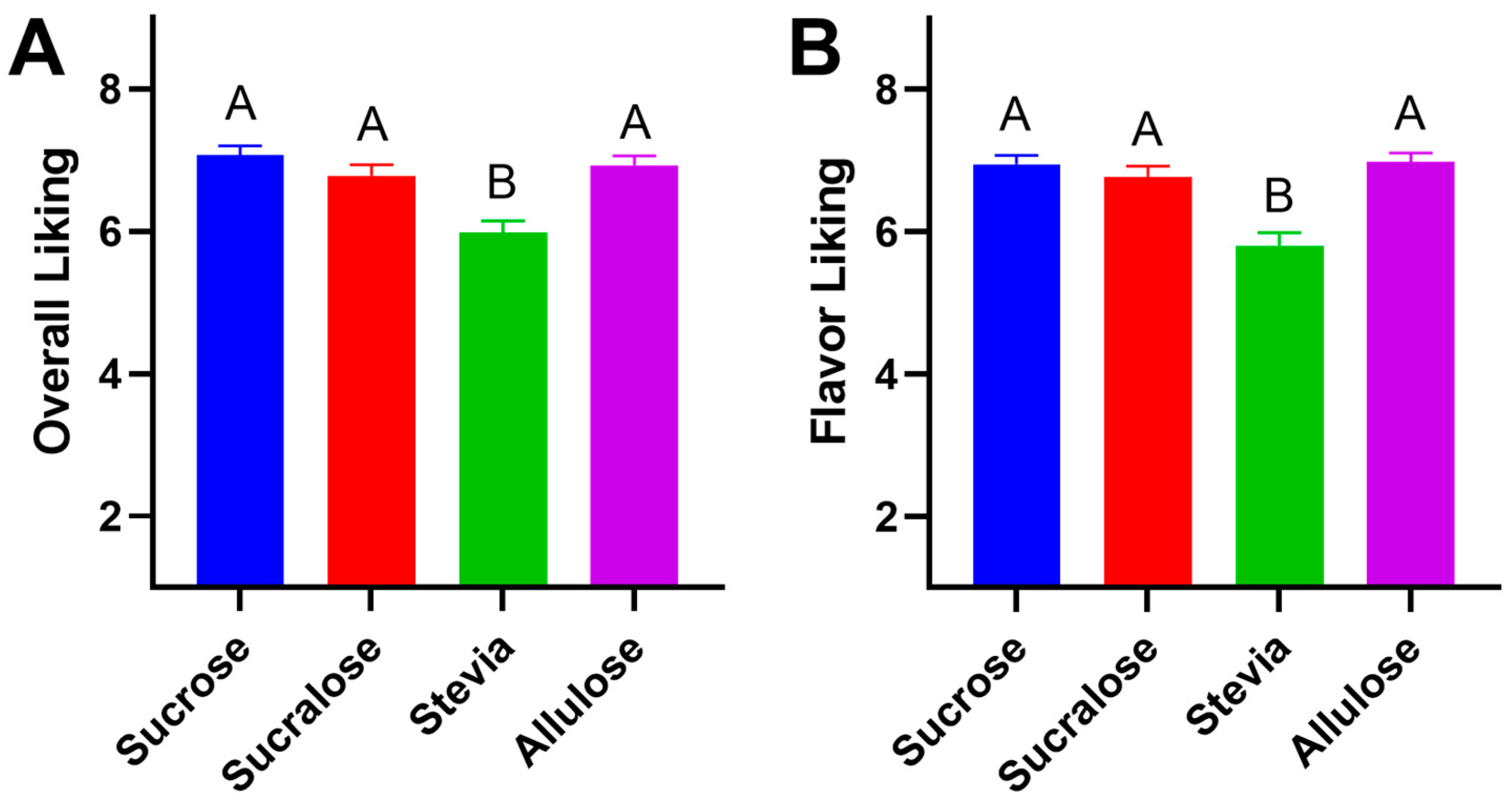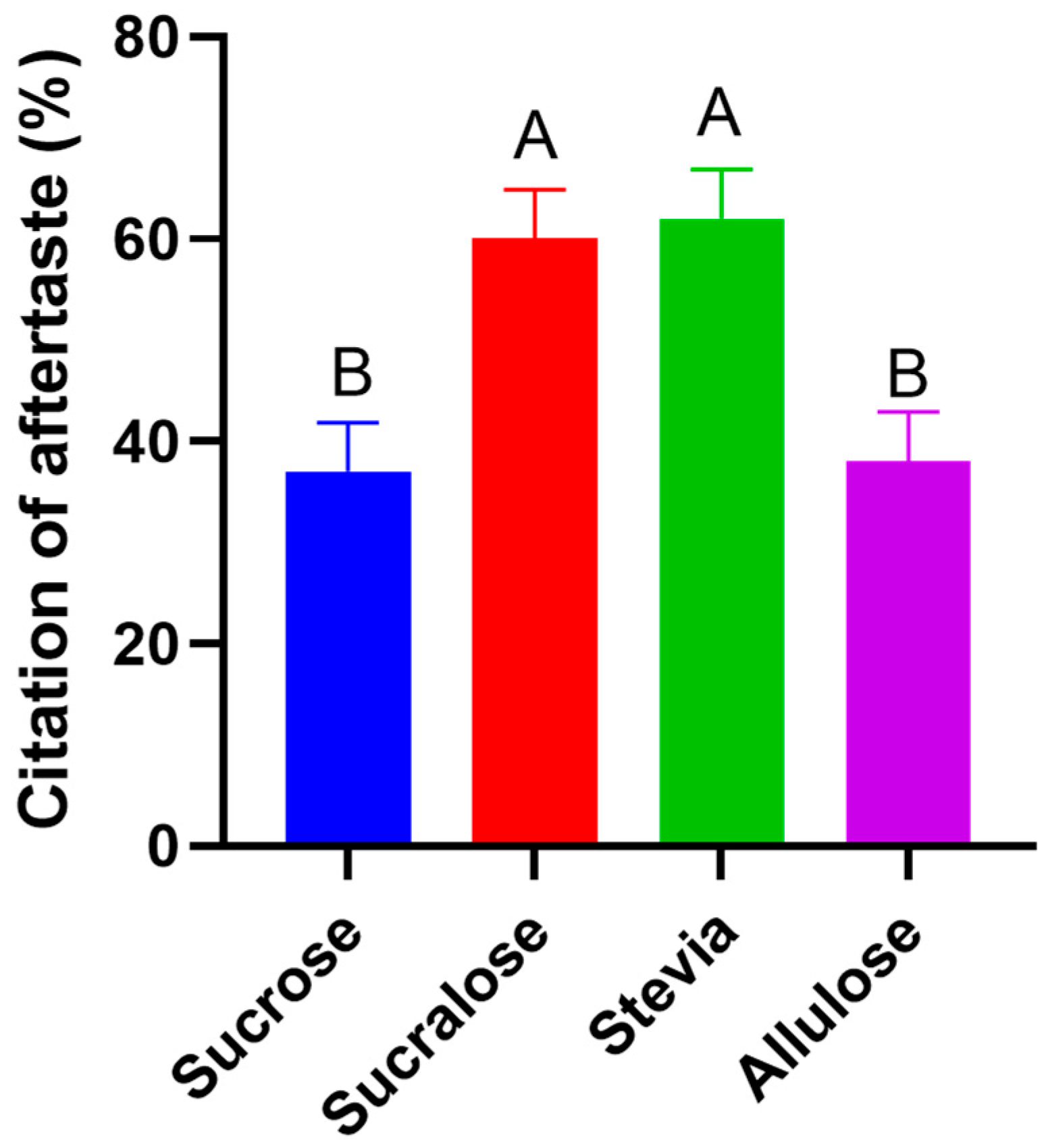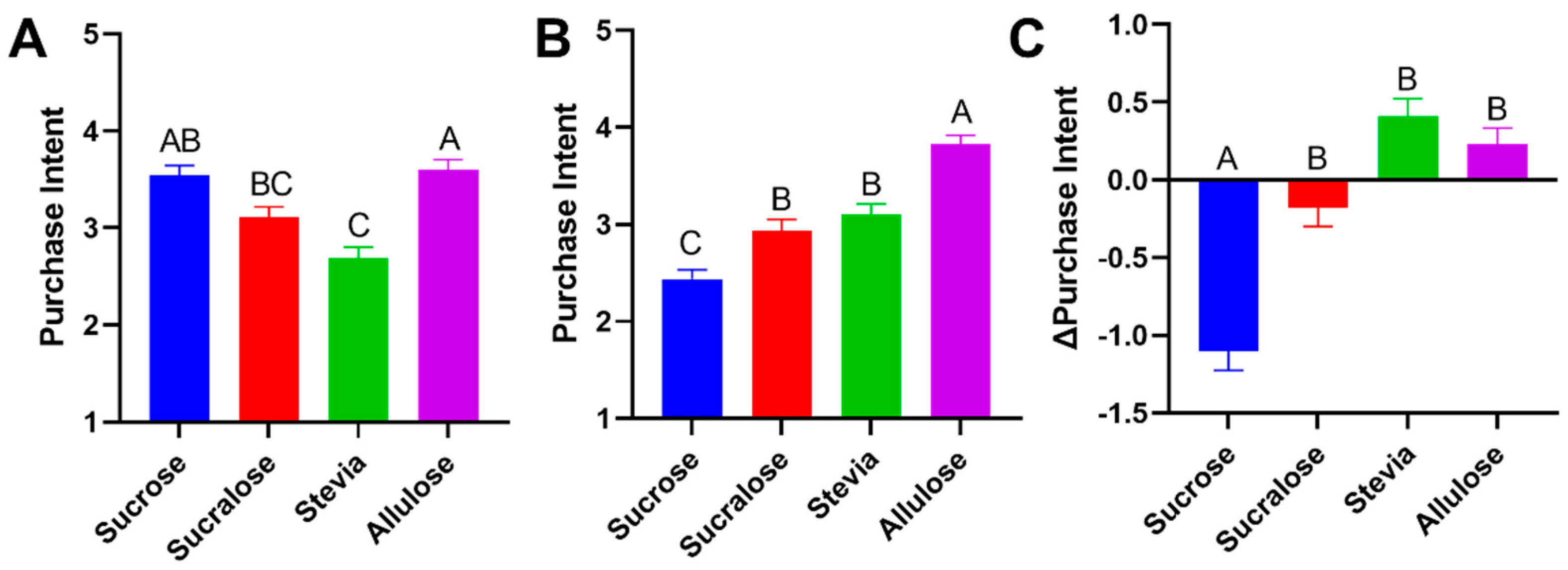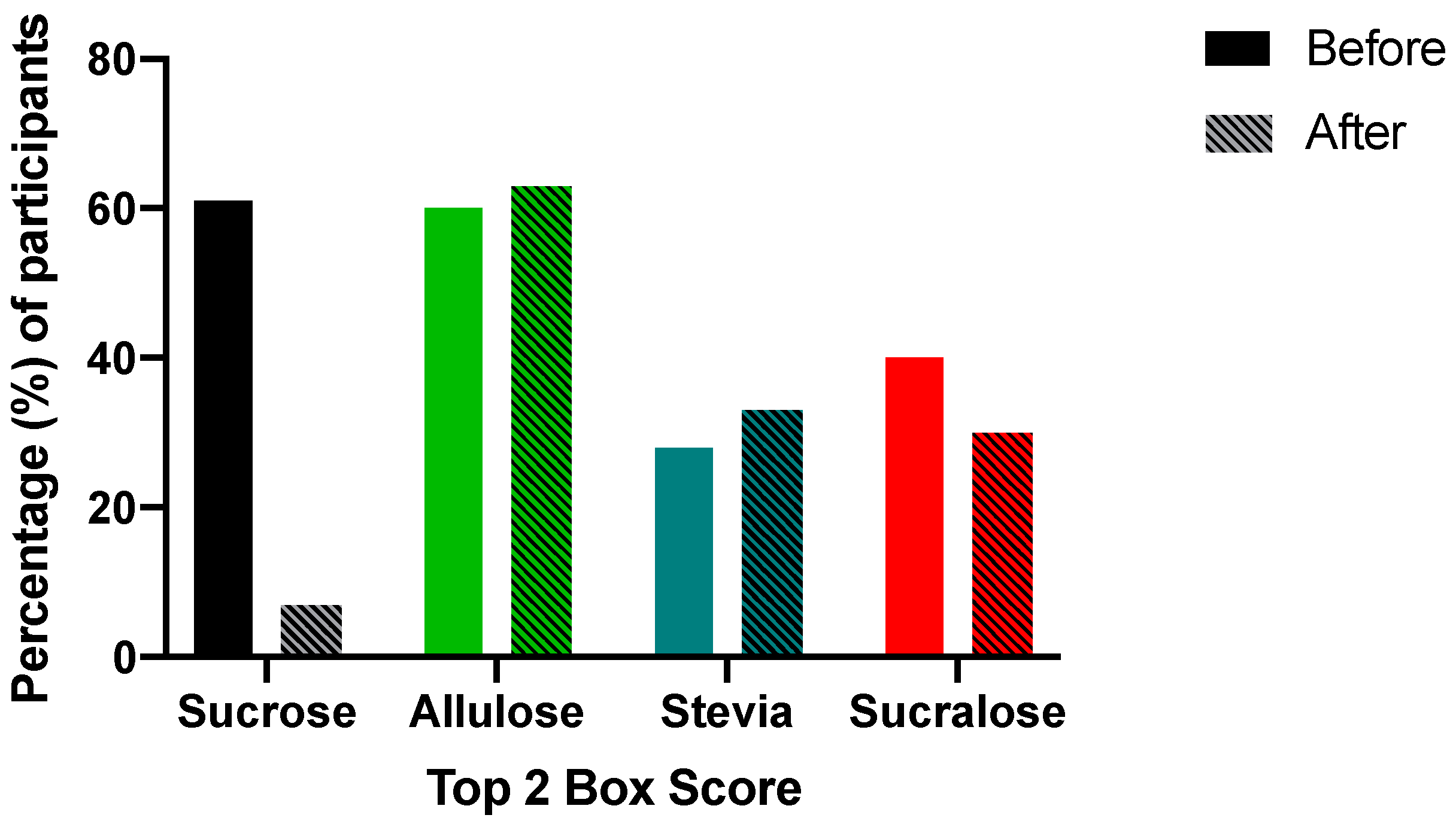Consumers Respond Positively to the Sensory, Health, and Sustainability Benefits of the Rare Sugar Allulose in Yogurt Formulations
Abstract
:1. Introduction
2. Materials and Methods
2.1. Samples—Ingredients and Preparation
2.2. Participants
2.3. Sample Evaluation and Questionnaire
2.4. Statistical Analysis
3. Results and Discussion
3.1. Allulose Performs on Par in Liking with Sucrose in Sweetening Yogurt
3.2. Few Sensory Defects Were Reported in Allulose Sweetened Samples
3.3. Consumer Perception’s Impact on Purchase Intent
Practical Implications and Future Directions
4. Conclusions
Supplementary Materials
Author Contributions
Funding
Institutional Review Board Statement
Informed Consent Statement
Data Availability Statement
Acknowledgments
Conflicts of Interest
References
- Marco, M.L.; Heeney, D.; Binda, S.; Cifelli, C.J.; Cotter, P.D.; Foligné, B.; Hutkins, R. Health benefits of fermented foods: Microbiota and beyond. Curr. Opin. Biotechnol. 2017, 44, 94–102. [Google Scholar] [CrossRef] [PubMed]
- Kok, C.R.; Hutkins, R. Yogurt and other fermented foods as sources of health-promoting bacteria. Nutr. Rev. 2018, 76 (Suppl. 1), 4–15. [Google Scholar] [CrossRef] [PubMed] [Green Version]
- Moore, J.B.; Sutton, E.H.; Hancock, N. Sugar Reduction in Yogurt Products Sold in the UK between 2016 and 2019. Nutrients 2020, 12, 171. [Google Scholar] [CrossRef] [PubMed] [Green Version]
- Grummon, A.H.; Smith, N.R.; Golden, S.D.; Frerichs, L.; Taillie, L.S.; Brewer, N.T. Health Warnings on Sugar-Sweetened Beverages: Simulation of Impacts on Diet and Obesity among U.S. Adults. Am. J. Prev. Med. 2019, 57, 765–774. [Google Scholar] [CrossRef]
- FDA. Changes to the Nutrition Facts Label. 2022. Available online: https://www.fda.gov/food/food-labeling-nutrition/changes-nutrition-facts-label#:~:text=The%20Nutrition%20Facts%20label%20on,make%20better%20informed%20food%20choices (accessed on 6 August 2022).
- Wee, M.; Tan, V.; Forde, C. A Comparison of Psychophysical Dose-Response Behaviour across 16 Sweeteners. Nutrients 2018, 10, 1632. [Google Scholar] [CrossRef] [PubMed] [Green Version]
- Hutchings, S.C.; Low, J.Y.Q.; Keast, R.S.J. Sugar reduction without compromising sensory perception. An impossible dream? Crit. Rev. Food Sci. Nutr. 2019, 59, 2287–2307. [Google Scholar] [CrossRef] [PubMed]
- Farhat, G.; Dewison, F.; Stevenson, L. Knowledge and Perceptions of Non-Nutritive Sweeteners Within the UK Adult Population. Nutrients 2021, 13, 444. [Google Scholar] [CrossRef] [PubMed]
- Schiano, A.N.; Gerard, P.D.; Drake, M.A. Consumer perception of dried dairy ingredients: Healthy, natural, and sustainable? J. Dairy Sci. 2021, 104, 12427–12442. [Google Scholar] [CrossRef] [PubMed]
- Mora, M.R.; Dando, R. The sensory properties and metabolic impact of natural and synthetic sweeteners. Compr. Rev. Food Sci. Food Saf. 2021, 20, 1554–1583. [Google Scholar] [CrossRef] [PubMed]
- Van Laar, A.D.E.; Grootaert, C.; van Camp, J. Rare mono- and disaccharides as healthy alternative for traditional sugars and sweeteners? Crit. Rev. Food Sci. Nutr. 2021, 61, 713–741. [Google Scholar] [CrossRef] [PubMed]
- Ahmed, A.; Khan, T.A.; Dan Ramdath, D.; Kendall, C.W.; Sievenpiper, J.L. Rare sugars and their health effects in humans: A systematic review and narrative synthesis of the evidence from human trials. Nutr. Rev. 2022, 80, 255–270. [Google Scholar] [CrossRef]
- FDA. FDA In Brief: FDA Looking at Nutrition Facts Labeling of Certain Sugars, Sweeteners; News and Events; Center for Food Safety and Applied Nutrition: College Park, MD, USA, 2020.
- Grunert, K. Consumer Attitudes to Food Quality Products: Emphasis on Southern Europe; Springer: Berlin/Heidelberg, Germany, 2013. [Google Scholar]
- Meneses, Y.; Cannon, K.J.; Flores, R.A. Keys to Understanding and Addressing Consumer Perceptions and Concerns about Processed Foods. Perceptions and Concerns about Processed Foods. Faculty Publications: Agricultural Leadership, Education & Communication Department. 2014, p. 83. Available online: http://digitalcommons.unl.edu/aglecfacpub/83 (accessed on 19 September 2022).
- Saraiva, A.; Carrascosa, C.; Raheem, D.; Ramos, F.; Raposo, A. Natural Sweeteners: The Relevance of Food Naturalness for Consumers, Food Security Aspects, Sustainability and Health Impacts. Int. J. Environ. Res. Public Health 2020, 17, 6285. [Google Scholar] [CrossRef]
- Team, M.P. Consumers Hold Companies Responsible for Sustainability. Available online: https://www.mintel.com/press-centre/social-and-lifestyle/consumers-hold-companies-most-responsible-for-sustainability-issues-but-also-think-they-can-make-a-difference (accessed on 19 September 2022).
- Wang, Z.; Qi, J.; Hinkley, T.C.; Nugen, S.R.; Goddard, J.M. Recombinant lactase with a cellulose binding domain permits facile immobilization onto cellulose with retained activity. Food Bioprod. Process. 2021, 126, 207–214. [Google Scholar] [CrossRef]
- Ushijima, B. A Rare Sweetness: Researching Healthier Forms of Sugar. Highlighting Japan September 2014. Available online: https://www.gov-online.go.jp/eng/publicity/book/hlj/html/201409/201409_10_en.html (accessed on 16 August 2022).
- IFIC. Food and Health Survey Report. Available online: https://foodinsight.org/wp-content/uploads/2022/06/IFIC-2022-Food-and-Health-Survey-Report-May-2022.pdf (accessed on 19 June 2022).
- Rothman, L.; Parker, M.J. Just-About-Right (JAR) Scales: Design, Usage, Benefits, and Risks. Micro Nano Lett. 2009, 1, 1–3. [Google Scholar]
- Tan, V.W.K.; Wee, M.S.M.; Tomic, O.; Forde, C.G. Rate-All-That-Apply (RATA) comparison of taste profiles for different sweeteners in black tea, chocolate milk, and natural yogurt. J. Food Sci. 2020, 85, 486–492. [Google Scholar] [CrossRef]
- Chadha, D.; Hamid, N.; Kantono, K.; Marsan, M. Changes in temporal sensory profile, liking, satiety, and postconsumption attributes of yogurt with natural sweeteners. J. Food Sci. 2022, 87, 3190–3206. [Google Scholar] [CrossRef]
- Palazzo, A.B.; Carvalho, M.A.R.; Efraim, P.; Bolini, H.M.A. The determination of isosweetness concentrations of sucralose, rebaudioside and neotame as sucrose substitutes in new diet chocolate formulations using the time-intensity analysis. J. Sens. Stud. 2011, 26, 291–297. [Google Scholar] [CrossRef]
- Tan, V.W.K.; Wee, M.S.M.; Tomic, O.; Forde, C.G. Temporal sweetness and side tastes profiles of 16 sweeteners using temporal check-all-that-apply (TCATA). Food Res. Int. 2019, 121, 39–47. [Google Scholar] [CrossRef] [PubMed]
- Ochiai, M.; Onishi, K.; Yamada, T.; Iida, T.; Matsuo, T. D-psicose increases energy expenditure and decreases body fat accumulation in rats fed a high-sucrose diet. Int. J. Food Sci. Nutr. 2014, 65, 245–250. [Google Scholar] [CrossRef]
- Nagata, Y.; Kanasaki, A.; Tamaru, S.; Tanaka, K. D-psicose, an epimer of D-fructose, favorably alters lipid metabolism in Sprague-Dawley rats. J. Agric. Food Chem. 2015, 63, 3168–3176. [Google Scholar] [CrossRef] [PubMed]
- Braunstein, C.R.; Noronha, J.C.; Glenn, A.J.; Viguiliouk, E.; Noseworthy, R.; Khan, T.A.; Sievenpiper, J.L. A Double-Blind, Randomized Controlled, Acute Feeding Equivalence Trial of Small, Catalytic Doses of Fructose and Allulose on Postprandial Blood Glucose Metabolism in Healthy Participants: The Fructose and Allulose Catalytic Effects (FACE) Trial. Nutrients 2018, 10, 750. [Google Scholar] [CrossRef] [PubMed]
- Hayashi, N.; Yamada, T.; Takamine, S.; Iida, T.; Okuma, K.; Tokuda, M. Weight reducing effect and safety evaluation of rare sugar syrup by a randomized double-blind, parallel-group study in human. J. Funct. Foods 2014, 11, 152–159. [Google Scholar] [CrossRef] [Green Version]
- Iida, T.; Kishimoto, Y.; Yoshikawa, Y.; Hayashi, N.; Okuma, K.; Tohi, M.; Izumori, K. Acute D-psicose administration decreases the glycemic responses to an oral maltodextrin tolerance test in normal adults. J. Nutr. Sci. Vitaminol. 2008, 54, 511–514. [Google Scholar] [CrossRef] [PubMed] [Green Version]
- Noronha, J.C.; Braunstein, C.R.; Glenn, A.J.; Khan, T.A.; Viguiliouk, E.; Noseworthy, R.; Sievenpiper, J.L. The effect of small doses of fructose and allulose on postprandial glucose metabolism in type 2 diabetes: A double-blind, randomized, controlled, acute feeding, equivalence trial. Diabetes Obes. Metab. 2018, 20, 2361–2370. [Google Scholar] [CrossRef]
- Han, Y.; Kwon, E.Y.; Yu, M.K.; Lee, S.J.; Kim, H.J.; Kim, S.B.; Choi, M.S. A Preliminary Study for Evaluating the Dose-Dependent Effect of d-Allulose for Fat Mass Reduction in Adult Humans: A Randomized, Double-Blind, Placebo-Controlled Trial. Nutrients 2018, 10, 160. [Google Scholar] [CrossRef] [PubMed] [Green Version]
- Hayashi, N.; Iida, T.; Yamada, T.; Okuma, K.; Takehara, I.; Yamamoto, T.; Tokuda, M. Study on the postprandial blood glucose suppression effect of D-psicose in borderline diabetes and the safety of long-term ingestion by normal human subjects. Biosci. Biotechnol. Biochem. 2010, 74, 510–519. [Google Scholar] [CrossRef] [PubMed] [Green Version]
- Reyes, M.M.; Castura, J.C.; Hayes, J.E. Characterizing Dynamic Sensory Properties of Nutritive and Nonnutritive Sweeteners with Temporal Check-All-That-Apply. J. Sens. Stud. 2017, 32, e12270. [Google Scholar] [CrossRef]
- Choi, Y.; Manthey, J.A.; Park, T.H.; Cha, Y.K.; Kim, Y.; Kim, Y. Correlation between in vitro binding activity of sweeteners to cloned human sweet taste receptor and sensory evaluation. Food Sci. Biotechnol. 2021, 30, 675–682. [Google Scholar] [CrossRef]
- Schiffman, S.S.; Booth, B.J.; Losee, M.L.; Pecore, S.D.; Warwick, Z.S. Bitterness of sweeteners as a function of concentration. Brain Res. Bull. 1995, 36, 505–513. [Google Scholar] [CrossRef]
- Green, B.G.; Lim, J.; Osterhoff, F.; Blacher, K.; Nachtigal, D. Taste mixture interactions: Suppression, additivity, and the predominance of sweetness. Physiol. Behav. 2010, 101, 731–737. [Google Scholar] [CrossRef] [Green Version]
- Reis, R.C.; Minim, V.P.; Bolini, H.M.; Dias, B.R.; Minim, L.A.; Ceresino, E.B. Sweetness equivalence of different sweeteners in strawberry-flavored yogurt. J. Food Qual. 2011, 34, 163–170. [Google Scholar] [CrossRef]
- Li, T.; Dando, R. Impact of Common Food Labels on Consumer Liking in Vanilla Yogurt. Foods 2019, 8, 584. [Google Scholar] [CrossRef] [PubMed] [Green Version]
- Jamaludin, H.; Elmaky, H.S.E.; Sulaiman, S. The future of food waste: Application of circular economy. Energy Nexus 2022, 7, 100098. [Google Scholar] [CrossRef]
- Kappes, S.M.; Schmidt, S.J.; Lee, S.-Y. Mouthfeel Detection Threshold and Instrumental Viscosity of Sucrose and High Fructose Corn Syrup Solutions. J. Food Sci. 2006, 71, S597–S602. [Google Scholar] [CrossRef]






| Sweetener | Information Provided |
|---|---|
| Sucrose | The sample that you have just tasted contains 10 g of added sugar per serving (20% of your daily recommended intake of added sugar), which is typical for this product. |
| Allulose | The sample that you have just tasted contains 0 g of added sugar and gets its sweetness from allulose, an upcycled natural sweetener that is produced in a sustainable way. |
| Stevia (Reb A) | The sample that you have just tasted contains 0 g of added sugar and gets its sweetness from stevia, a natural sweetener. |
| Sucralose | The sample that you have just tasted contains 0 g of added sugar and gets its sweetness from sucralose, an artificial sweetener. |
Publisher’s Note: MDPI stays neutral with regard to jurisdictional claims in published maps and institutional affiliations. |
© 2022 by the authors. Licensee MDPI, Basel, Switzerland. This article is an open access article distributed under the terms and conditions of the Creative Commons Attribution (CC BY) license (https://creativecommons.org/licenses/by/4.0/).
Share and Cite
Mora, M.R.; Wang, Z.; Goddard, J.M.; Dando, R. Consumers Respond Positively to the Sensory, Health, and Sustainability Benefits of the Rare Sugar Allulose in Yogurt Formulations. Foods 2022, 11, 3718. https://doi.org/10.3390/foods11223718
Mora MR, Wang Z, Goddard JM, Dando R. Consumers Respond Positively to the Sensory, Health, and Sustainability Benefits of the Rare Sugar Allulose in Yogurt Formulations. Foods. 2022; 11(22):3718. https://doi.org/10.3390/foods11223718
Chicago/Turabian StyleMora, Margaux R., Zhixin Wang, Julie M. Goddard, and Robin Dando. 2022. "Consumers Respond Positively to the Sensory, Health, and Sustainability Benefits of the Rare Sugar Allulose in Yogurt Formulations" Foods 11, no. 22: 3718. https://doi.org/10.3390/foods11223718
APA StyleMora, M. R., Wang, Z., Goddard, J. M., & Dando, R. (2022). Consumers Respond Positively to the Sensory, Health, and Sustainability Benefits of the Rare Sugar Allulose in Yogurt Formulations. Foods, 11(22), 3718. https://doi.org/10.3390/foods11223718









